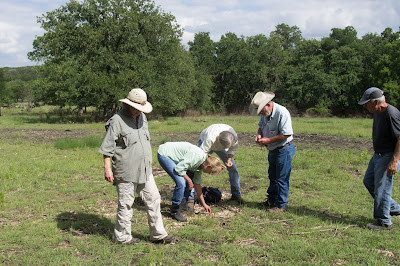Last week was another interesting time at the farm. On Thursday afternoon, Bryan Jameson, Archeology Steward of the Texas Historical Commission, and his wife, Carol Macaulay-Jameson, Senior Lecturer in the Department of Anthropology, Baylor University visited to visit with Allan and Jef and John and me, and to look at the arrowheads, spear points, stone tools and the like that have been picked up on the property over the years. Bryan and Carol are volunteers at the Clifton Historical Museum, and are acquaintances of our cousins, Kathy Cash and Eric Vanderbeck of Cranfills Gap, who also joined us on Thursday.
The majority of the artifacts were collected by Allan’s and my parents, Bob and Evelyn Jones, who purchased the farm in 1959 and spent most of their weekends here until they turned it over to Allan and me in the early 1990s. They had a lot of help from my Aunt Frankie and my uncles, Watt Atwood and Gene Cash. Here are Mother and Aunt Frankie with my Uncle Watt on the left, my Aunt Frankie in the middle, and my Uncle Gene on the back right.
The photo below is of my mom on the left, my dad and Aunt Frankie. It was taken at the kitchen table in the farmhouse, probably sometime in the 1960s.
And here are Aunt Frankie and Mother. I think they have been fishing instead of looking for arrowheads from the looks of the tackle box and the heavy bucket...presumably filled with fish from our stock tanks.
Most of the artifacts we have were picked up in a small plot near the Middle Fork of Neils Creek that we call “the sanctuary.” Since the area is level, and near a water source, we think it might have been a spot where the early native people camped. Eric and Carol discuss what treasures might be hidden beneath the grass.
Bryan thinks he has spotted a piece of flint, or chert, that has been "worked."
The sanctuary was plowed frequently over the years and was planted in crops that would provide food for deer, turkey and other wildlife. This was the only area of the farm that has been regularly cultivated for the past 60 or so years. We surmise that there may be other treasures lurking beneath the rich grasses along the creek, but they will likely stay hidden.
Because the sanctuary was plowed often, from the early 1960s until the late 1980s, my mother and my Aunt Frankie, liked to walk the freshly-turned soil and look for arrowheads, spear points and stone tools. They found quite an assortment…not only projectile points, but scrapers, hammer stones, knives and a drill. We were amazed to learn from Bryan and Carol that many of the items we have been showing to friends and family over the years are thousands of years old. A few are from Native American tribes that roamed this valley in the last several hundred years, but most were made by ancient peoples 2,500-10,000 years BC. We now have a new project…sorting, organizing and cataloging our new-found treasures. Once we have done that, I’ll post some photos.
There is another hillside area on the property which has never yielded points or tools, but is rich in the type of stone known as chert, or flint. It is Bryan’s assessment that this was used as a quarry where material to make weapons or tools was gathered.
The third area we investigated in winter is a rattlesnake den. In the past we have cautiously (very cautiously!) explored the rocky outcroppings that shelter the den. On sunny days in the late fall and early spring, the snakes can be seen around the entrance or napping in the sun on nearby rocks.
Since the days have been warm for some time, we were reasonably certain that all the snakes had left the den to forage in the surrounding woods and pastures. We were right; no snakes were lurking near the den. The dogs were very curious about what other critters might be using the den area in the “off season” but we kept a close watch on them just in case.
Bryan and Carol did not think the overhang, even several thousand years ago, would have been large enough to be used as a permanent home by native cultures. Instead, they thought it might have provided a temporary shelter in bad weather or been used by travelers. We have never found any artifacts in that area, so they are probably correct. Who knows, though, what Goat Hill, as we call the farm, might have looked like 10,000 years ago? It’s certainly fertile ground for speculation.







No comments:
Post a Comment